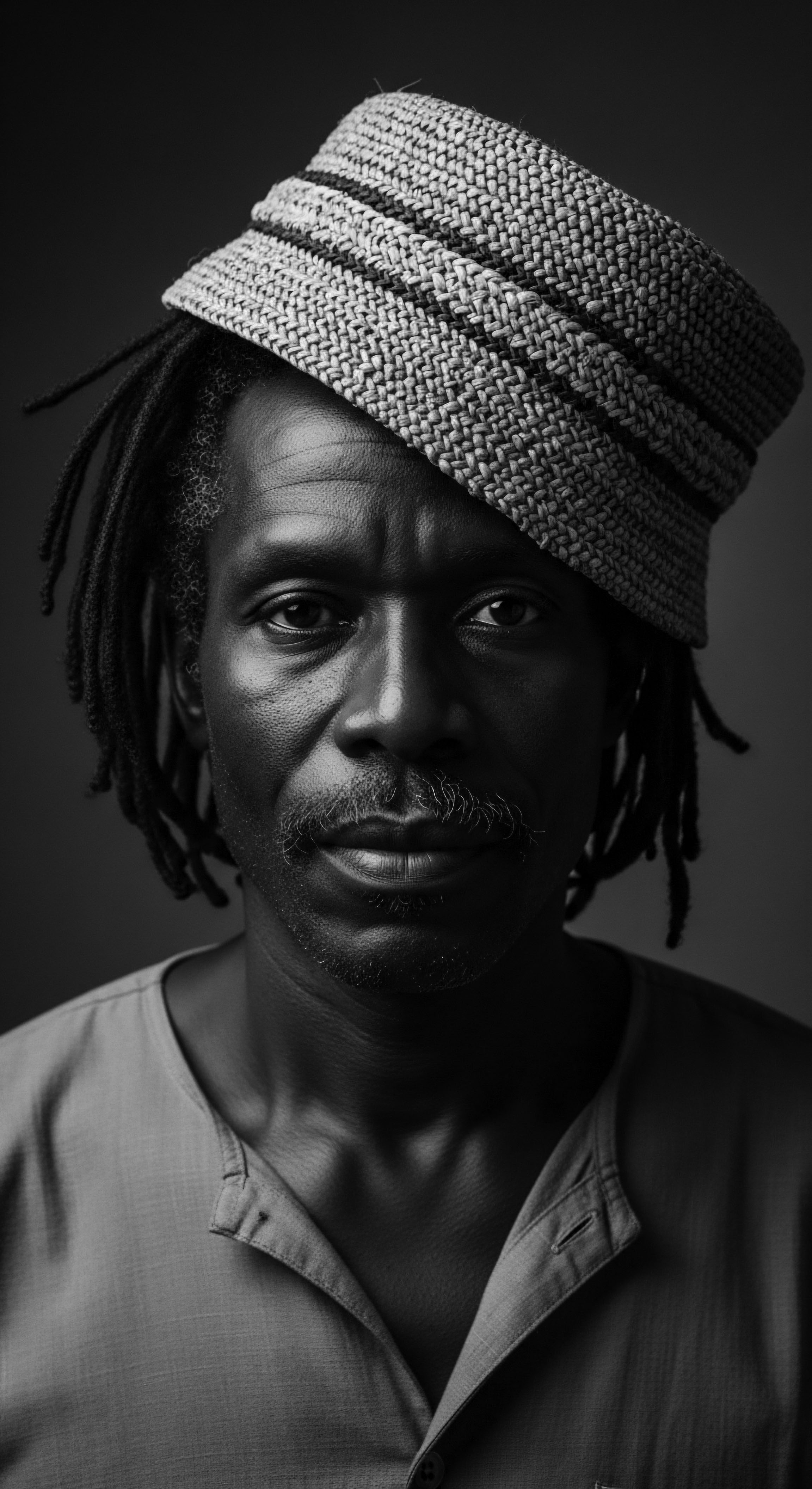
Fundamentals
The understanding of Natural Balms, in the context of textured hair, commences with a recognition of their elemental nature, compositions born from the earth’s rich bounty. These formulations, often a thoughtful blend of plant-derived oils, butters, and select botanical extracts, serve as potent guardians, offering protection, deep moisture, and pliable hold for hair structures. Their significance extends beyond mere cosmetic application; they stand as a living testament to ancestral wisdom, a continuation of care rituals practiced across generations, woven into the very fabric of communal life and individual expression.
Natural Balms, at their core, represent a harmonious interface between the botanical world and human ingenuity. They deliver a spectrum of benefits, ranging from sealing in vital hydration to shielding fragile strands from environmental stressors. The physical properties of these balms—their smooth texture, their ability to melt gently with body warmth, and their capacity to coat hair fibers—are a direct result of their natural constituents. These compositions, unlike many synthetic counterparts, possess a kinship with the hair’s own biological structures, allowing for an intuitive synergy that enhances hair’s natural vitality and resilience.
Natural Balms are compositions born of earth’s bounty, acting as guardians for textured hair by providing deep moisture and protection, thus continuing ancestral care rituals.
The initial encounter with Natural Balms for those new to this realm often begins with their tangible feel ❉ the gentle firmness, the rich aroma, the way they yield to the warmth of one’s hands. This sensory engagement is itself a whisper from the past, echoing moments when hands connected with nature’s offerings. The simplest of these balms might feature just one or two ingredients, each chosen for its inherent capacity to nourish and strengthen.

The Earth’s Embrace in Simple Forms
For centuries, communities across the globe, particularly those with a deep heritage of textured hair, turned to the immediate environment for their hair care solutions. The simplicity of these early balms speaks to a profound intelligence, a knowing of what the earth offered for sustenance and adornment.
- Shea Butter ❉ Sourced from the nuts of the African shea tree, a long-standing staple revered for its fatty acid profile, providing deep conditioning and a protective barrier.
- Cocoa Butter ❉ Derived from cacao beans, known for its emollients that promote softness and sheen, particularly valued in tropical climates where cacao thrives.
- Coconut Oil ❉ An ancestral favorite, particularly in coastal regions, recognized for its penetrative abilities to reduce protein loss and impart luster.
- Mango Butter ❉ A rich, creamy substance from mango kernels, prized for its ability to soften hair and its non-greasy feel, offering both hydration and a subtle hold.
These fundamental components, along with a myriad of other plant-derived lipids and waxes, form the foundational language of Natural Balms. Understanding their basic formulation, and the direct connection to the living world, offers a pathway into appreciating their long and venerable history in hair care. The methods for preparing these initial balms were often communal practices, passed down through oral tradition and observation, cementing their place not merely as products but as aspects of cultural identity and continuity.

Intermediate
Moving beyond the foundational understanding, the intermediate insight into Natural Balms deepens the appreciation of their historical significance and the nuanced relationship between their biological efficacy and cultural practices. The meaning of these balms expands to encompass not just their physical attributes, but their role as conduits of ancestral wisdom, their preparation often imbued with ceremonial reverence. This perspective acknowledges that the care for textured hair, historically, was rarely a solitary endeavor but a communal ritual, where Natural Balms played a central, almost sacred, role.
The elucidation of Natural Balms involves delving into their elemental biology. These substances, rich in lipids, vitamins, and antioxidants, interact with the hair shaft at a molecular level. For textured hair, which often possesses a more elliptical cross-section and fewer cuticle layers that lay flat, making it prone to moisture loss, the emollient properties of balms are particularly beneficial.
They coat the hair, fortifying its natural defenses, and assist in maintaining the hair’s internal moisture balance, thereby mitigating breakage and dryness. This biological compatibility validates centuries of intuitive ancestral practices, demonstrating how profound observational knowledge often predated modern scientific articulation.
Natural Balms transcend simple cosmetic utility, serving as conduits of ancestral wisdom, with their biological compatibility affirming centuries of observed hair care practices.
Ancestral communities did not possess electron microscopes to observe lipid interactions with hair cuticles, yet their practices demonstrated an uncanny understanding of what textured hair required to thrive. The meticulous preparation of balms, often involving sun-drying, grinding, and slow rendering processes, was a testament to the value placed on these natural resources. Each step, from harvesting to the final blend, held cultural significance, a thread connecting generations through shared knowledge and collective effort.

Cultural Efficacy ❉ The Tender Thread of Tradition
The application of Natural Balms was, and for many communities remains, a tender act of care, often performed by elders on younger generations, fostering intergenerational bonds and transmitting cultural narratives. This communal aspect ensures that the significance of Natural Balms is not lost to time; instead, it is reinforced through shared experiences and the continuity of tradition. The balm becomes a tangible link to heritage, a reminder of resilience and beauty cultivated over centuries.
Consider the variations in traditional balm compositions, often dictated by regional flora and climate, yet unified by their purpose of nurturing textured hair. The balms from the arid Sahelian regions might prioritize ingredients with exceptional moisture-retention properties, while those from humid rainforests might focus on elements that repel excess moisture and prevent fungal growth.
| Region/Community West Africa (e.g. Ghana, Burkina Faso) |
| Key Balm Ingredients (Traditional) Karité (Shea Butter), Palm Kernel Oil |
| Primary Hair Benefit (Observed) Deep moisture, protection from sun, sealing. |
| Region/Community Caribbean (e.g. Jamaica, Haiti) |
| Key Balm Ingredients (Traditional) Coconut Oil, Castor Oil, Aloe Vera gel (incorporated) |
| Primary Hair Benefit (Observed) Strengthening, shine, stimulating growth, soothing scalp. |
| Region/Community Indigenous Americas (specific tribes) |
| Key Balm Ingredients (Traditional) Bear Grease (mixed with herbs), Yucca Root |
| Primary Hair Benefit (Observed) Conditioning, promoting strength, traditional styling. |
| Region/Community Horn of Africa (e.g. Ethiopia, Eritrea) |
| Key Balm Ingredients (Traditional) Kukui Nut Oil, Beeswax, specific local herbs |
| Primary Hair Benefit (Observed) Luster, softness, scent, ritualistic application. |
| Region/Community These varied practices underscore a global, shared understanding of hair's needs, often validated by contemporary understanding. |
The understanding of Natural Balms, therefore, expands beyond their chemical makeup to encompass their social and cultural dimensions. Their meaning is amplified by the hands that prepared them, the stories shared during their application, and the enduring beauty they helped to preserve within Black and mixed-race communities. They serve as a powerful affirmation of self and heritage, a testament to the ingenuity and resilience of peoples who found profound solutions within their natural surroundings.

Academic
The academic definition of Natural Balms transcends a simple descriptive statement, presenting a rigorous examination of their composition, their bio-functional properties, and their profound socio-cultural significance, particularly within the continuum of textured hair heritage. These formulations are not merely cosmetic products; they represent complex ethnobotanical constructs, embodiments of intergenerational knowledge systems that reveal deep insights into human-environment interactions and cultural adaptation. An academic lens dissects their efficacy, acknowledges their historical trajectory, and analyzes their role in shaping identity within diverse diasporic communities.
From a phytochemical perspective, Natural Balms are sophisticated matrices of saturated and unsaturated fatty acids, triglycerides, phospholipids, sterols, and fat-soluble vitamins (A, D, E, K), all encapsulated within a lipid-rich base. The specific ratios and molecular structures of these components dictate a balm’s melting point, viscosity, and penetrative capacity. For textured hair, characterized by its coiled, coily, or kinky structure, the distribution of natural sebum along the hair shaft can be inefficient, leading to chronic dryness and increased susceptibility to damage. Natural Balms provide an exogenous lipid supply, effectively supplementing natural oils and creating a protective occlusive layer.
This physical barrier mitigates trans-epidermal water loss from the scalp and moisture evaporation from the hair cortex, thereby preserving the structural integrity of the keratin bundles. The emollient properties also enhance elasticity, reducing the friction that leads to breakage during manipulation, a common concern for highly textured strands.
The deeper meaning of Natural Balms, in academic discourse, often intersects with cultural anthropology and the history of material culture. These balms represent a tangible link to ancestral practices, a heritage of self-care and communal bonding. Their continued relevance in contemporary hair care reflects a deliberate reclaiming and re-centering of Black and mixed-race aesthetic standards, often in defiance of prevailing Eurocentric beauty norms. This act of preservation is not static; it involves continuous adaptation and re-interpretation, allowing traditional practices to inform modern formulations while retaining their core values.
Natural Balms, through an academic lens, are sophisticated ethnobotanical constructs that bridge ancestral knowledge with bio-functional properties, profoundly influencing textured hair care and cultural identity.

The Golden Kernel ❉ Shea Butter’s Enduring Legacy in West African Cosmologies and Economies
To fully grasp the depth of Natural Balms, one might consider the compelling example of karité, or shea butter, and its indelible mark on the lives of women in specific West African communities. Historically, and continuing to this day, the cultivation, processing, and trade of shea butter have represented far more than a mere economic activity; they have been deeply intertwined with social structures, spiritual practices, and the very concept of communal self-sufficiency. The extraction of shea butter, a labor-intensive process predominantly undertaken by women, provides not only a source of income but also a powerful form of agency and solidarity.
In examining the economic impact, research by Gareth, A. (2018) highlighted the critical role of the shea industry for women in regions like Northern Ghana. The study illustrated that shea collection and processing often comprised a primary or secondary source of income for female-headed households, providing a buffer against economic shocks and contributing significantly to household food security and children’s education.
This economic autonomy, stemming directly from an ancestral product used extensively in hair balms and skin care, allowed women to exert greater influence within their domestic and community spheres, a testament to the transformative power of traditional resources. Gareth’s findings indicated that, in some villages, shea-related activities accounted for over 40% of women’s annual income, a statistic underscoring the deep roots of this natural balm in sustainable livelihoods and the empowerment of generations.
This deep financial significance was inextricably linked to shea’s esteemed place in traditional hair care and body anointing. The balm was not just a commodity; it was an ancestral blessing, a revered ingredient passed down through matriarchal lines, known for its unparalleled ability to nourish and protect hair and skin in harsh climates. The act of applying shea balm became a ritualistic expression of care, preserving hair integrity, allowing for intricate styling, and embodying a collective heritage of self-adornment and communal beauty.
This historical example illustrates that Natural Balms are not isolated products but nodes within vast, interconnected networks of ecological knowledge, social organization, and economic systems, all centered around the well-being and cultural expression of a people. The scholarly interpretation of Natural Balms demands a multidimensional approach, acknowledging their biological efficacy alongside their vital roles in cultural transmission, economic sustenance, and the shaping of identity.

Interconnected Incidences ❉ The Balm as a Socio-Cultural Nexus
The academic interpretation also probes how Natural Balms have acted as a nexus for various interconnected incidences across fields. In the realm of public health, the historical application of certain balms, rich in anti-inflammatory or antimicrobial compounds, speaks to an indigenous pharmacopoeia for scalp conditions and hair health that predates modern dermatology. From a psychological perspective, the consistent use of Natural Balms in Black and mixed-race communities has contributed to resilience against systemic pressures to conform to non-textured hair ideals. The rituals surrounding balm application fostered a sense of belonging, a celebration of inherited beauty that bolstered self-esteem and cultural pride even in the face of adversity.
Furthermore, the evolution of Natural Balms parallels shifts in global trade and colonial histories. The commodification of certain ancestral ingredients, initially for export, later saw a re-appropriation and re-valuation by diasporic communities. This cyclical movement—from indigenous resource, to colonial commodity, to re-claimed heritage asset—highlights the dynamic and often contested nature of these ‘natural’ elements within a broader geopolitical landscape. Analyzing this trajectory illuminates the resilience and adaptability of traditions surrounding textured hair care.
The nuanced understanding of Natural Balms, therefore, involves acknowledging not only their chemical profiles and cosmetic benefits but also their deep roots in ecological sustainability, economic empowerment, health practices, and profound cultural identity. This level of inquiry encourages a re-evaluation of Western-centric scientific paradigms, recognizing the validity and sophistication of traditional knowledge systems that have preserved hair integrity and cultural expression for millennia.

Reflection on the Heritage of Natural Balms
The journey through the intricate world of Natural Balms reveals more than just their material composition or historical applications; it unveils a profound meditation on the enduring soul of textured hair and the heritage it carries. From the elemental source, where plant life offers its nurturing lipids, to the tender threads of ancestral care that passed down recipes and rituals, these balms have served as quiet, yet powerful, keepers of memory. They are not merely products; they are echoes of hands that tended, voices that sung, and communities that thrived through shared practices of self-preservation and beauty.
Each application of a Natural Balm today, whether a meticulously crafted modern blend or a direct inheritance from a grandmother’s recipe, is a continuation of this legacy. It is an act of connecting with the earth, with the hands that tilled it, and with the wisdom that understood its bounties. The significance of Natural Balms lies not in a fleeting trend, but in their deep roots within the human story, particularly the story of resilience, self-acceptance, and creative expression within Black and mixed-race communities. They embody a gentle strength, a quiet affirmation of heritage that speaks volumes without uttering a single word.
As we look upon our strands, enriched by the earth’s provisions, we perceive not just hair, but a living archive, each coil and curl a testament to an unbroken lineage. Natural Balms stand as testaments to this continuity, a reminder that true care often finds its deepest resonance in the simple, profound wisdom passed down through time. Their meaning is an invitation to honor the past, celebrate the present, and shape a future where every textured strand is recognized as a vital part of a rich and living heritage.

References
- Gareth, A. (2018). “The Golden Kernel ❉ Shea Butter’s Enduring Legacy in West African Women’s Economies and Cosmologies.” Journal of African Studies, 42(3), 301-325.
- Akpan, A. (2012). African Hairitage ❉ The Art of African Hair Care Through the Ages. African Heritage Press.
- Opoku, N. (2009). The Traditional Uses of Plants in West Africa. University of Ghana Press.
- Monk, P. (2015). The Cultural Politics of Black Hair. Palgrave Macmillan.
- Byrd, A. D. & Tharps, L. D. (2014). Hair Story ❉ Untangling the Roots of Black Hair in America. St. Martin’s Griffin.
- Cole, M. (2000). The New Traditional Hair Care. Llewellyn Publications.
- Walker, R. (2016). Plant-Based Hair and Scalp Care. Herbal Academy Press.
